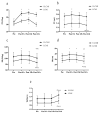Effect of Acute Judo Training on Countermovement Jump Performance and Perceived Fatigue among Collegiate Athletes
- PMID: 36554889
- PMCID: PMC9778897
- DOI: 10.3390/ijerph192417008
Effect of Acute Judo Training on Countermovement Jump Performance and Perceived Fatigue among Collegiate Athletes
Abstract
This study focused on the effect of acute Judo training on countermovement jump (CMJ) performance and perceived fatigue among a group of highly trained collegiate judo athletes. Twenty male judo athletes participated in this study (age: 20.65 ± 1.22 years, weight: 84.17 ± 28.45 kg). Participants were assessed for CMJperformance changes before, immediately after (0 h), 12 h after, and 24 h after judo training (JT) using unloaded CMJ(CMJunloaded) and loaded CMJ(CMJloaded). All the jumps were performed on a force plate, and the force-time curves were collected for further analysis. Respondents' perceptions were evaluated using the modified rating of perceived exertion (mRPE) before, after (0 h), 12 h, and 24 h after JT. CMJparameters were analyzed at four measured points using a one-way repeated analysis of variance. Effect sizes (ES) and percentage changes before versus 24 h after JT were calculated for comparison. Associations between the CMJparameters and mRPE were analyzed using the Pearson product-moment correlation. The ratio of flight time to contact time significantly decreased, whereas the eccentric duration, concentric duration, and total duration significantly increased (p < 0.05) in both CMJs 24 h after JT. Compared with CMJunloaded, CMJloaded had a significantly lower (p < 0.05) flight time, jump height, peak velocity, and peak power. The mRPE and CMJloaded peak velocity showed moderate- to high-level negative correlation results both 0 and 24 h after training (r = -0.543, p < 0.05; r = -0.479, p < 0.05). In this study, we only observed the effect of fatigue on the neuromuscular (NM) system 24 h after JT. CMJloaded height may help to better determine fatigue state compared with CMJunloaded. According to the results, the neuromuscular effects of fatigue were not observed until 24 h after a single high-intensity training. Therefore, when arranging high-intensity special training or strength and conditioning training, one should reduce the volume of training appropriately to avoid fatigue accumulation and reduce the risk of sports injuries.
Keywords: modified rating of perceived exertion; neuromuscular fatigue; sport performance.
Conflict of interest statement
The authors declare no conflict of interest.
Figures

Similar articles
-
Effects of judo-specific intermittent training on lower-limb impulse and specific performance in judokas.PeerJ. 2025 Jun 4;13:e19491. doi: 10.7717/peerj.19491. eCollection 2025. PeerJ. 2025. PMID: 40487059 Free PMC article.
-
Effect of acute fatigue and training adaptation on countermovement jump performance in elite snowboard cross athletes.J Strength Cond Res. 2015 Jan;29(1):37-46. doi: 10.1519/JSC.0000000000000622. J Strength Cond Res. 2015. PMID: 25029001
-
Predicting fatigue using countermovement jump force-time signatures: PCA can distinguish neuromuscular versus metabolic fatigue.PLoS One. 2019 Jul 10;14(7):e0219295. doi: 10.1371/journal.pone.0219295. eCollection 2019. PLoS One. 2019. PMID: 31291303 Free PMC article.
-
Age-Related Variation in Male Youth Athletes' Countermovement Jump After Plyometric Training: A Meta-Analysis of Controlled Trials.J Strength Cond Res. 2017 Feb;31(2):552-565. doi: 10.1519/JSC.0000000000001444. J Strength Cond Res. 2017. PMID: 28129282 Review.
-
Rating of Perceived Exertion for Quantification of Training and Combat Loads During Combat Sport-Specific Activities: A Short Review.J Strength Cond Res. 2017 Oct;31(10):2889-2902. doi: 10.1519/JSC.0000000000002047. J Strength Cond Res. 2017. PMID: 28933715 Review.
Cited by
-
Determinants of the severity of sports injuries among students in sports disciplines at higher education institutions.Front Public Health. 2025 Jun 9;13:1565393. doi: 10.3389/fpubh.2025.1565393. eCollection 2025. Front Public Health. 2025. PMID: 40552224 Free PMC article.
-
Effects of judo-specific intermittent training on lower-limb impulse and specific performance in judokas.PeerJ. 2025 Jun 4;13:e19491. doi: 10.7717/peerj.19491. eCollection 2025. PeerJ. 2025. PMID: 40487059 Free PMC article.
-
Assessment Methods of Sport-Induced Neuromuscular Fatigue: A Scoping Review.Int J Sports Phys Ther. 2025 Jul 2;20(7):943-956. doi: 10.26603/001c.141230. eCollection 2025. Int J Sports Phys Ther. 2025. PMID: 40620399 Free PMC article.
References
-
- McLean B.D., Coutts A.J., Kelly V., McGuigan M.R., Cormack S.J. Neuromuscular, endocrine, and perceptual fatigue responses during different length between-match microcycles in professional rugby league players. Int. J. Sports Physiol. Perform. 2010;5:367–383. doi: 10.1123/ijspp.5.3.367. - DOI - PubMed
-
- Bonato M., Rampichini S., Ferrara M., Benedini S., Sbriccoli P., Merati G., Franchini E., La Torre A. Aerobic training program for the enhancements of HR and VO2 off-kinetics in elite judo athletes. J. Sports Med. Phys. Fitness. 2015;55:1277–1284. - PubMed
MeSH terms
LinkOut - more resources
Full Text Sources

